
Visit Shrines
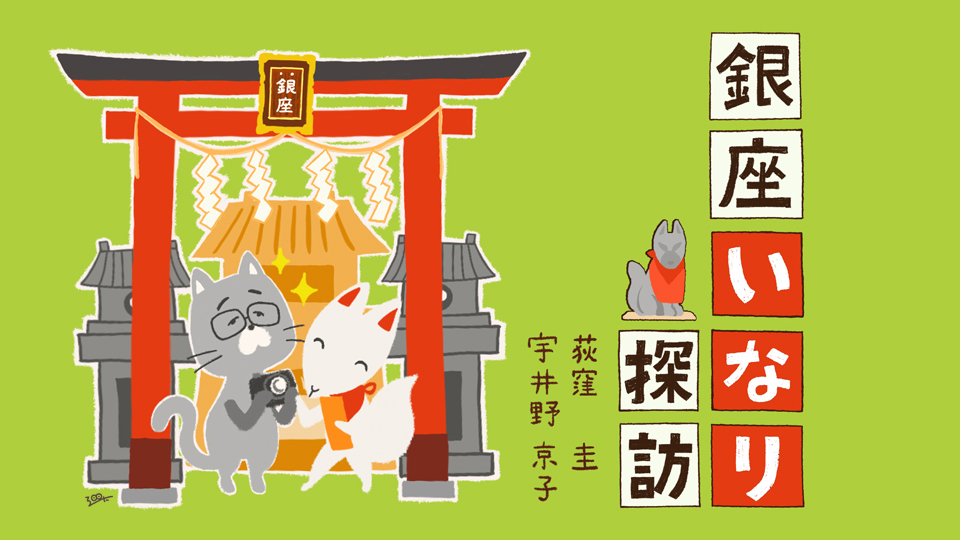
Visit Ginza’s Inari Shrines Vol.2 Asahi Inari Shrine
2020.05.01
Visit Ginza’s Inari Shrines. Let us begin today’s excursion.
Ginza has 8 districts, from 1-chome to 8-chome, but for most people, “Ginza” is the area covering 3-chome and 4-chome. In the 4-chome intersection stand Wako and Mitsukoshi Department Store, and in the 3-chome intersection stands Ginza Matsuya Department Store.
Our destination is Asahi Inari Shrine in Ginza 3-chome.
Asahi Inari is located not on Chuo Dori but on one of the smaller streets, a few blocks away from the main street.
If you walk to the east along Matsuya Dori from the Ginza 3-chome intersection and pass by Oji Hall, you will find a small shrine on the first floor of a building on the corner of a small intersection. That is Asahi Inari.
Inari Shrines are basically found in the backstreets.

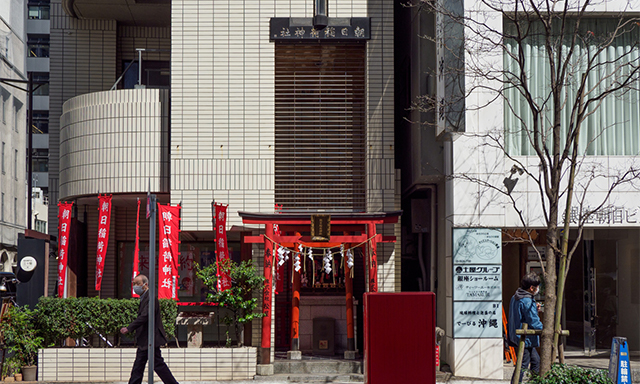
- Uino
- Do you remember coming here?
- Ogikubo
- Isn’t this the spot where the shutters came down just as we passed by?
- Uino
- That’s right. It must have been just around 5:00 pm. We saw the shutters rattling down just like a store. (laughs)
- Ogikubo
- I couldn’t help taking a movie of it.
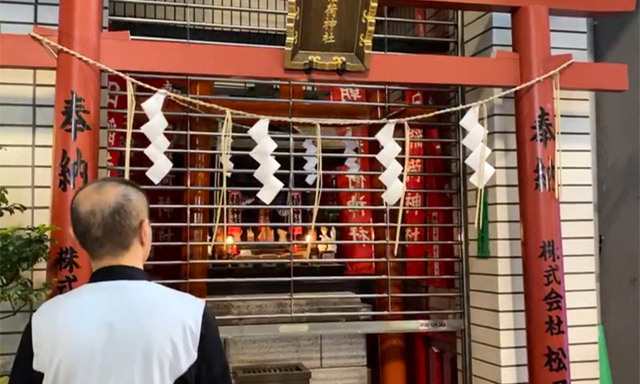
- Uino
- This is a remote shrine for worship. Would you like to visit the main shrine?
- Ogikubo
- Are we allowed to go up?
- Uino
- Yes, we can take the elevator to the main shrine on the roof.
- Ogikubo
- Ever since I happened to pass by ten to twenty years ago, I have stopped by this shrine whenever I am in the neighborhood. I could tell from how it was designed that the main shrine was on the roof, but I had no idea that it was open to the public. I wish I had known earlier. Then this would not have been my first time.
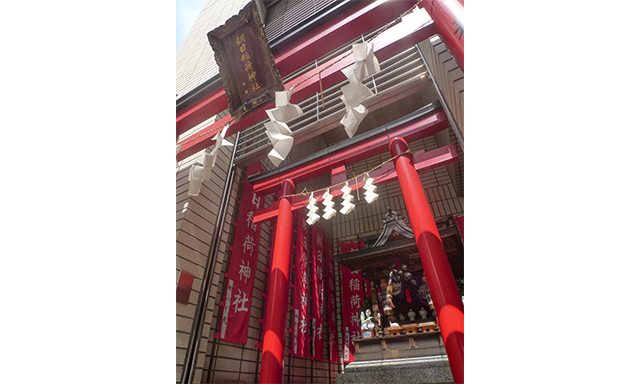
- Uino
- Then let us go inside the building. There is an elevator near the entrance.
- Ogikubo
- It is my first time inside this building. It says Shrine Office on the eighth floor and Main Shrine on the roof. I guess that means that we can go up.
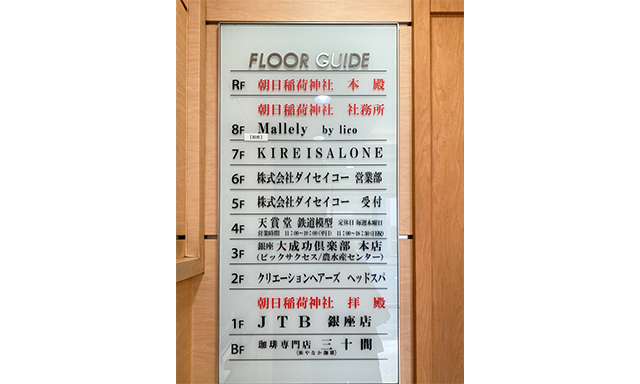
- Uino
- The roof is open on weekdays. You can also get a “goshuin” stamp at the shrine office on the eighth floor.
- Ogigkubo
- Let us go up.
- Uino
- The elevator only goes up to the eighth floor. We will take the stairs to the roof.
- Ogikubo
- How kind. It says “Please take the exterior stairs to the main shrine on the roof” on the door leading to the roof.
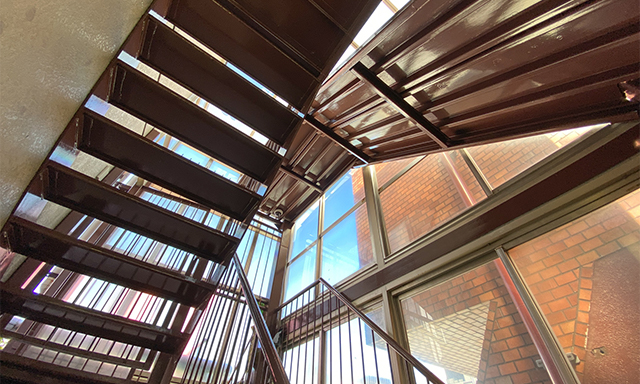
- Uino
- This is the roof. The entire roof area serves as the precincts of the shrine. The Hatsuuma Festival celebrated under the Chinese calendar is held up here on the roof. It is almost as if the shrine is protecting the Ginza 3-chome area from the skies.
- Ogikubo
- It even has a “temizuya” (small roofed pavilion for ritual purification by washing hands and rinsing mouths) and “torii” gate, as well as the main shrine. What a creative way to preserve a local shrine in Ginza, where land prices are so high. It is also a splendid idea to have the “haiden” front shrine at ground level. And the sound… What is that sound?
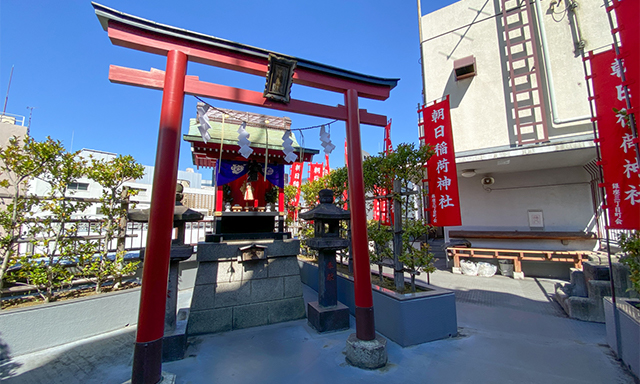
- Uino
- A microphone is set up in the “haiden” front shrine to be heard through speakers on the roof, so that the god in the main shrine can catch every sound and wish.
- Ogikubo
- It is somewhat mysterious to hear clapping and the sound of coins being thrown into the offering box on the roof.
- Uino
- There is one more secret!
- Ogikubo
- A secret?
- Uino
- Did you notice that the shrine has been designed so that when you look up from the front shrine, you feel a connection to the roof?
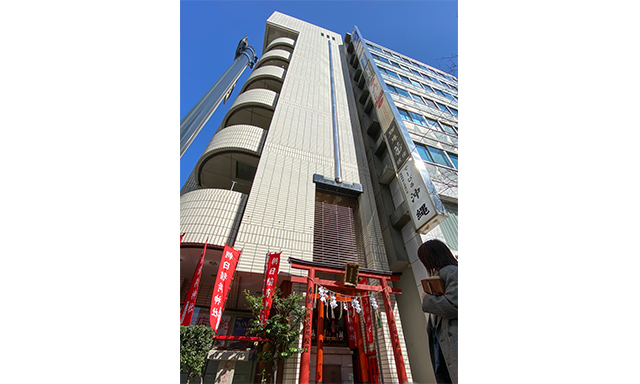
- Ogikubo
- Yes, I noticed that. I thought it was uniquely designed.
- Uino
- It is actually not only designed to look so. A pipe filled with eatth connects the ground and roof, which are thus “connected by earth.”
- Ogikubo
- I see. The shrine grounds on the roof and the front shrine and ground are all connected by earth.
- Uino
- The shrine had to be built so that “the roof stretched out into the sky and the pillars touched the ground” (according to the “Asahi Inari Shrine History”) and the Association of Shinto Shrines acknowledged that, with the pipe filled with earth stretching along the wall from the ground coming, the pillars in effect touched the ground. What an idea.
- Ogikubo
- That kind of idea would only emergeg in central Tokyo, effectively using land while preserving the local shrine. It could have been a pioneering case of recent trends to re-develop the precincts of a shrine with developers. Konpira-gu Shrine in Toranomon and Fukutoku Inari Shrine in Nihonbashi are recent cases. What did the shrine look like before the building was built?
- Uino
- This area was a parking lot and the shrine was located on the second floor.
- Ogikubo
- And before that?
- Uino
- It had been burnt down so no one knows of the details.
- Ogikubo
- I see. Then let us see what it says in the “Asahi Inari Shrine History.”。
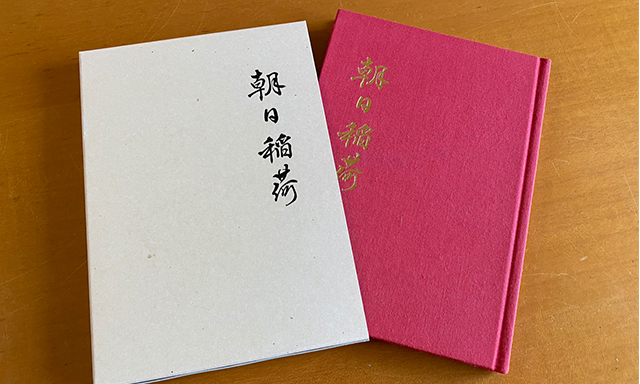
- Ogikubo
- It says that the shrine was originally built by Sanjusankenbori, so the local guardian god must have been worshiped here in the late 18th century (Meiwa or Annei periods).
- Uino
- Sanjusankenbori is the narrow street behind the building where the Asahi Inari Shrine is currently located. It is in between Chuo-dori and Showa-dori. The channel has been buried and is currently a street.
- Ogikubo
- It was still a channel on a map of Tokyo from 1924 (Taisho 13). I also see a bridge called Asahi-bashi Bridge. It seems the channel was buried after World War II.
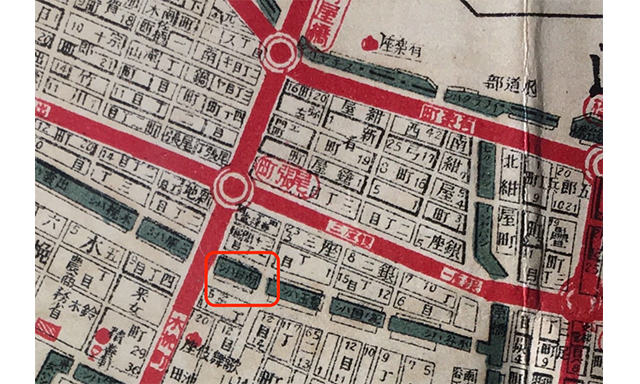
- Uino
- That is quite an old map. Does the name Asahi Inari come from the bridge?
- Ogikubo
- If you look at an older map from the Edo period… the bridge has not been built yet. Therefore, I would assume Asahi Inari Shrine was built first, and the bridge took its name from the shrine. Many bridges are named after a nearby shrine – Tenjinbashi Bridge and Inaribashi Bridge, for example.
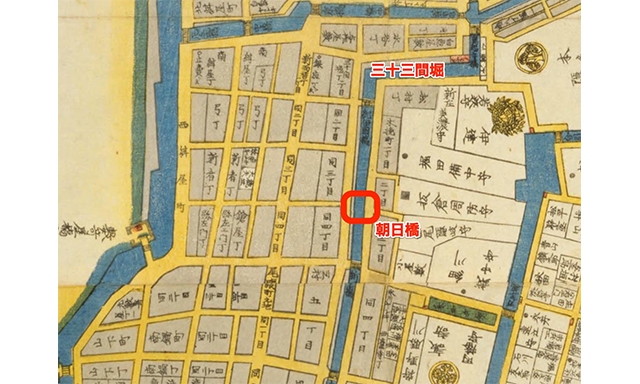
- Uino
- Then where did the name “Asahi” originate?
- Ogikubo
- I’m not sure. Perhaps a beautiful sunrise could be viewed from here, since the land around Tsukiji is low, having been reclaimed during the Edo period. That could be the story.
- Uino
- Asahi Inari Shrine was inundated by waters from Sanjusankenbori in a large earthquake toward the end of the Edo period. Which great earthquake are we referring to?
- Ogikubo
- It must be the Great Ansei Earthquake. According to “Buko Nenpyo,” a book covering events that occurred during the Edo period, it was the largest earthquake since 1703 (Genroku 16). What happened after it was inundated?
- Uino
- There is an interesting story about that. A miracle occurred during the Taisho period. After the Great Kanto Earthquake, when Sanjusankenbori dried up and the floor of the channel could be seen, the spirit that had been lost in the Great Ansei Earthquake rose. Asahi Inari Shrine was rebuild, enshrining this spirit.。
- Ogikubo
- I am curious to know what the spirit looked like. Do you know?
- Uino
- That is…
- Ogikubo
- (Excitement)
- Uino
- That is unknown. Even the people at the shrine office said that they had never seen it. We are not supposed to see these venerable spirits. Naturally, there are no records of them. It is probably a territory of horror that you are not supposed to set foot into.
- Ogikubo
- That is true. The important thing is not the identity of the spirit, but the fact that the spirit lost in an earlier earthquake reappeared in the next one.
- Uino
- So that is why it is worshiped as the guardian god of Ginza 3-chome.
Hence, when you come to Ginza 3-chome, come one block in from the main street to visit Asahi Inari Shrine. You will be able to see many people putting their hands together in front of a shrine uniquely designed, with the main shrine on the roof and the “haiden” front shrine on ground level, to accommodate its urban surroundings.
All List
- Visit Ginza’s Inari Shrines Vol.2 Asahi Inari Shrine
- 2020.08.01 Vol.3 Exploring Ginza in the Edo Period on an old map
- 2020.11.01 Visit Ginza’s Inari Shrines Vol. 4 Kakugo Inari Shrine
- 2021.02.01 Visit Ginza’s Inari Shrines Vol. 5 Azuma Inari
- 2021.05.01 Visit Ginza’s Inari Shrines Vol.6 Kabuki Inari
- 2021.08.01 Visit Ginza’s Inari Shrines Vol.7 Ginza Inari in Ginza 2-chome
- 2021.11.01 Visiting Ginza’s Shrines Vol. 8 Kumagai Inari Shrine
- 2022.02.01 Visit Ginza Shrines Vol. 9 Saiwai Inari Shrine
- 2022.05.01 Visit Ginza’s Shrine Vol. 10 Mimeguri Shrine and Shusse Jizoson on the roof of Mitsukoshi Department Store
- 2022.08.01 Visit Ginza’s Shrines Vol. 11 Komparu Inari
- 2022.11.01 Visit Ginza’s Inari Shrines Vol.12 Mankin Ryujin Seiko Inari Shrine
- 2023.02.01 Visit Ginza’s Shrines Vol.13 Hachikan Shrine
- 2023.05.01 Visit Ginza’s Inari Shrines Vol.14 Hoju Inari Shrine
- 2023.08.01 Visit Ginza’ Inari Shrines Vol. 15 Ryuko Fudo-son
- 2023.11.01 Visit Ginza’s Shrines Vol. 16 Hodo Inari Shrine
- 2024.02.01 Visit Ginza’s Shrines Vol. 17 Toyoiwa Inari Shrine
- 2024.05.01 Visit Ginza’s Inari Shrines Vol. 18 Yasuhira Shrine
- 2024.08.01 Visit Ginza’s Inari Shrines: Final Edition








